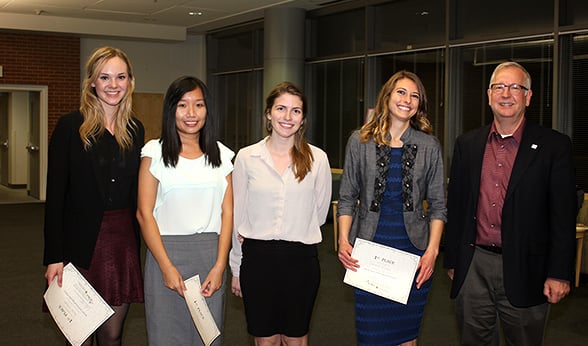Opioid abuse is one of the nation’s most severe public health crises. The problem strikes close to home, with nearly 900 Coloradans dying of intentional or unintentional drug overdoses in 2014. Many of those deaths came from misusing prescription medications such as Vicodin, Percocet and OxyContin, three of the most prescribed opioid painkillers. Addiction to those drugs also is leading to a surge in heroin use.
 The winners of the 2016 competition, along with Colorado School of Public Health Dean David Goff.
The winners of the 2016 competition, along with Colorado School of Public Health Dean David Goff.
Public health experts, health care practitioners and lawmakers are among those working hard to find solutions to the epidemic, and recently teams of University of Colorado Denver | Anschutz Medical Campus students joined the cause. About 55 students competed in this year’s Rocky Mountain Region Public Health Case Competition, competing to find innovative solutions that could alleviate the crisis. The annual event was hosted by the Colorado School of Public Health (ColoradoSPH) and run by its students.
Inventive ideas were not in short supply—including one proposal that would create specially equipped buses and design smartphone apps that could give addiction sufferers an accessible and discreet way to receive help recovering.
The proposal, named “Heals on Wheels” by the team, would use the vehicle to take back drugs, screen patients and give them referrals for treatment, educate and train people about drugs that stop overdoses and exchange needles.
Christy Colalancia, a student getting a master’s degree in public health, was a member of the winning team. She said a model for the idea was mobile mammography clinics, and the team considered the challenge of creating effective outreach strategies.
“We were thinking about what has worked and what didn’t work in the past. Our idea was as original as we could make it, but by taking into consideration evidence-based approaches,” Colalancia said.
Inventive ideas
Competition was stiff, with the panel of judges impressed by each of the proposals.
“We had a real belief that if any one of them were implemented, it would improve the public health of Colorado,” said ColoradoSPH Dean David Goff, MD, PhD, one of the judges.
Finishing second was a team with an idea to improve the rehab system in southeast Colorado by adding case managers who would work to educate and support patients. The case workers also would become liaisons between patients and doctors.
The third-place team proposed developing a drug takeback program that would allow people to return unused medication any day of the year by dropping the medications in secured bins at pharmacies around the state. Currently, some communities, government agencies and others including the Skaggs School of Pharmacy and Pharmaceutical Sciences will collect drugs for disposal, but most programs are one-day events. Additionally, many rural areas, where the opioid abuse problem is most severe, do not have those programs.
A growing problem
Colorado is one of the states hit hardest by the opioid epidemic, according to the Centers for Disease Control and Colorado Health Institute. In 2014, Colorado had 899 deaths related to drug overdoses. That works out to 16.3 deaths per 100,000 residents, which is up 68 percent since 2002. Colorado’s fatality rate is above the national average of 14.7 drug-related deaths per 100,000.
Twelve counties, including Denver and Adams counties, had rates of more than 20 deaths per 100,000 residents, making them among the highest in the nation.
Research also shows that prescription pain killers are a gateway drug, with 75 percent of heroin users saying they abused painkillers before switching drugs, according to nationwide stats from the CDC.
Real-world challenges
The goal of the annual competition is to give students across varied disciplines the experience of working as members of interdisciplinary teams, Goff said. It also gives them the chance to design innovative solutions to real-world health problems. Up to six students had to research the problem, develop a proposal, craft a presentation and answer questions from judges. They also needed to ensure their ideas could be implemented for less than $3 million and address challenges to implementation.
“I think one of the greatest parts of the program is getting a real-world scenario to try to solve in a limited amount of time, using limited funds and resources, and having an integrated approach,” Colalancia said.
The teams also had to beat the clock—students had 24 hours before their presentations were due. It led to some bleary eyes at the awards ceremony.
The competition was open to students from the ColoradoSPH, the School of Medicine, College of Nursing, Graduate School and the pharmacy school, among others. Students from CU Boulder, Colorado State University and the University of Northern Colorado also participated.
Representing CU Anschutz on the judges’ panel for the final round were Goff and Robert Valuck, PhD, a professor in the pharmacy school and director of the Colorado Consortium for Prescription Drug Abuse Prevention. Colorado Department of Public Health and Environment Executive Director and Chief Medical Officer Dr. Larry Wolk, state Sen. Jim Smallwood and state Senator-elect Dominick Moreno also were judges.




